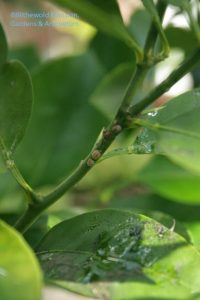Scale – on houseplants
Raise your hand if your houseplants don’t have scale. Anyone, anyone? If they don’t, I’m willing to bet that either Mother Nature loves lucky-you especially (though she may have another plague in store, beware); you have only four houseplants, all begonias; or your plants have been infested with scale insects in the past and you have somehow managed to banish it from your house. If your plants do have scale, don’t be embarrassed. You’re in good company (says me).
 I freely admit to having disgusting scale on a few of my plants at home. (For Mr. McGregor’s Daughter’s houseplant census, I also admit to having upwards of 85 plants inside my approximately 1000 sq. foot house…) And I’m sorry to say that ever since we stopped using systemic pesticides, a few scale have found their way back into the greenhouse here and there. If you’re not already familiar with these sapsuckers, scale generally look like crusty brown or waxy yellowish scabs and are often found on the underside of leaves along the midrib, tucked into leaf axils or along the stem. (Mealy bug is also a type of scale which resembles sticky grey cotton goo.)
I freely admit to having disgusting scale on a few of my plants at home. (For Mr. McGregor’s Daughter’s houseplant census, I also admit to having upwards of 85 plants inside my approximately 1000 sq. foot house…) And I’m sorry to say that ever since we stopped using systemic pesticides, a few scale have found their way back into the greenhouse here and there. If you’re not already familiar with these sapsuckers, scale generally look like crusty brown or waxy yellowish scabs and are often found on the underside of leaves along the midrib, tucked into leaf axils or along the stem. (Mealy bug is also a type of scale which resembles sticky grey cotton goo.)
Scale life-cycle in a nutshell (ha!): Eggs hatch under the protective shell of the female and start their life out as “crawlers”. They don’t travel far or fast – but that would explain how they get from plant to plant especially in a cheek-by-jowl living arrangement. Once they’ve found their spot they lose their legs and settle in for a suck. After molting and morphing into their adult selves, male scale grow wings but lose the ability to eat (no mouth). Males use their day or two window of opportunity to search for and mate with females. Females meanwhile develop a crusty protective shell from their castoff molts.
I have never noticed any flyers, eggs or “crawlers” but I guess I haven’t paid very close attention. I do always notice a fresh crop of immature scale (the small yellowish ones), their honeydew poop and the opportunistic sooty mold that sticks to it. I periodically – probably once a week at home – put plants in the sink for a bath and I go after the individual scale with an insecticidal fingernail.
The recommended treatment (besides systemic pesticides, or introducing another insect into your house to eat the scale – which might be worth a try) is to scrape them off and give the plant a dilute soap and/or horticultural oil wash and a water rinse. But take care to test your chosen method before treating the whole plant. Ferns, for one, are notoriously sensitive to anything but a gentle fingernail and room-temp water, and citrus don’t love oil.
So, fess up now – do your houseplants have scale? What do you do?
